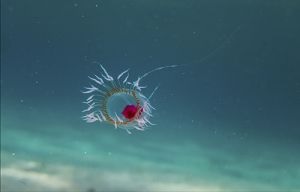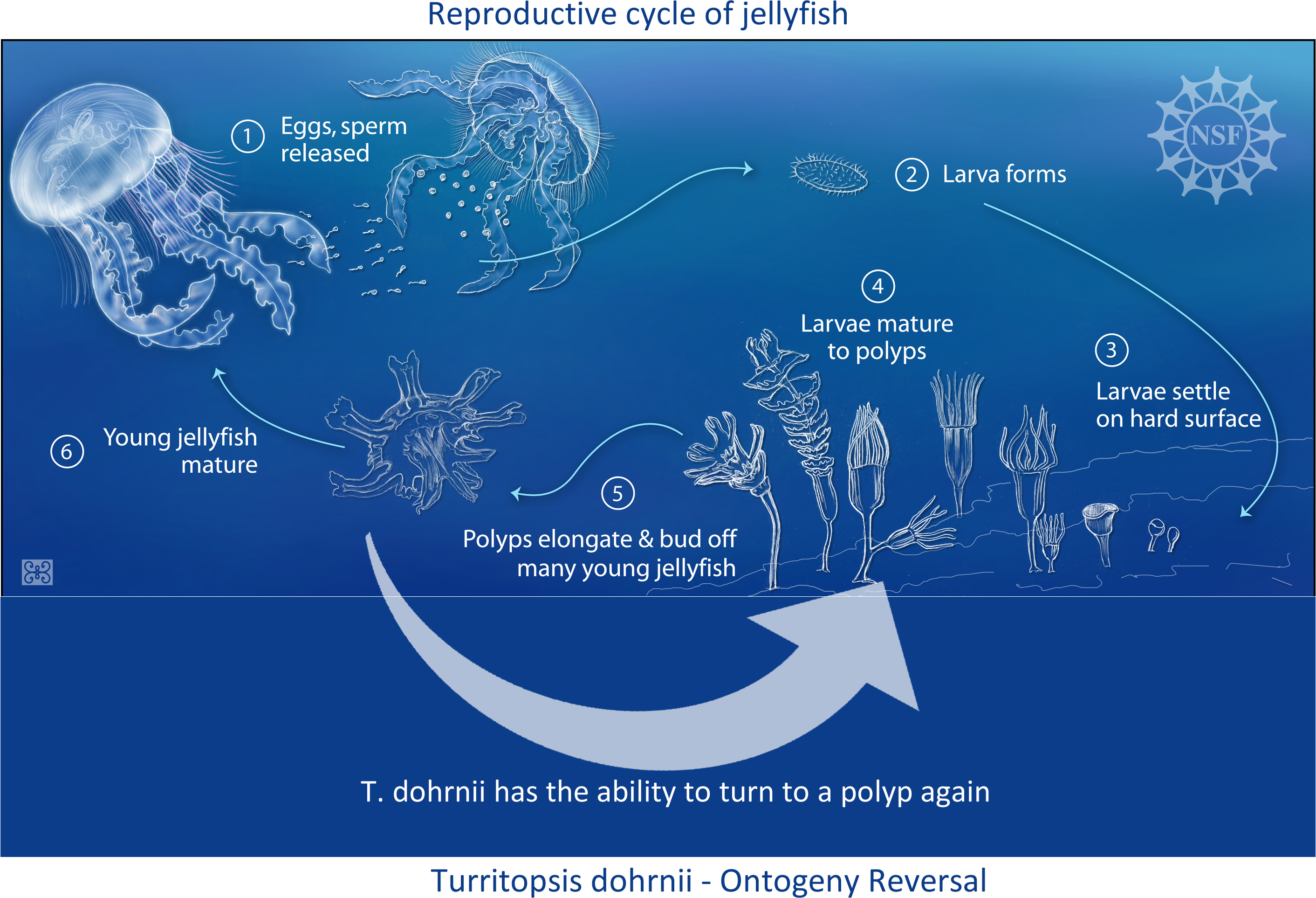Aging in Reverse – Immortal Jellyfish
Immortality, Anti-Aging, and Afterlife are issues that have been on the human mind for thousands of years.
Ever since Gods of the Greek Pantheon could turn certain humans to be immortal and Utnapishtim became the only man to escape death, according to the Mesopotamian Mythology, humans have been trying to unlock the secrets to eternal youth.

source CC BY-SA 4.0
How is Immortality perceived and how can humans defeat ‘Death’?
In its religious meaning, afterlife1 refers to the soul or spirit of the individual that continues to exist forever. There are many beliefs & variations depending on the religion.
Scientifically, longevity may refer to technologies for life extension such as cryonics.
There have also been various (many of them successful) attempts aiming to reverse aging (to a certain extent) using medicine or even cosmetic surgery.
One interesting (yet still hypothetical) futuristic process is mind uploading, where your brain will be scanned and uploaded to a computer and then transferred to a humanoid or a computer for any potential future use.
Some futurists share the optimistic idea that if we manage to remain alive until 2050 (so if you are born before 1970, perhaps it is best not to read this), you may actually achieve immortality
“The only thing wrong with immortality is that it tends to go on forever.”
― Herb Caen (American journalist 1916 – 1997)
Can someone be immortal?
Well, the (short) answer is YES.
The long answer though, goes: If you are a jellyfish AND your scientific name is Turritopsis Dohrnii AND you live in the Caribbean or North America AND if no predator in the dark see kills you, then YES.

Let’s learn more about this fascinating species that can defeat death (sort of).
A tremendous once-in-a-lifetime discovery!
This incredible behaviour has actually been discovered (like many other ‘Eureka moments) by accident!
As per Professor Ferdinando Boero, the Turritopsis Dohrnii was discovered by two students, while they thought they were observing another hydrozoan which was Turritopsis nutricula
Sommer (one of the students) who reared the medusae in the lab actually forgot about them. They were supposed to grow, spawn, and produce new planulas. These would grow into polyps which would produce new jellyfish.
When Sommer checked the rearing jar the next time, there were lots of newly settled polyps on its bottom. Puzzled by this, Sommer and Bavestrello continued their observations. They found that the new medusae, when stressed, would fall on the bottom of the jar and transformed straight into polyps, skipping the fertilization and larval stages described above.
This was even stranger – like a butterfly transforming back into a caterpillar.
source

In other words, after finding a number of new polyps in the jar, the students observed that the jellyfish would drop down to the bottom, transforming itself into polyps, skipping the whole spawning process!
Even if this was a significant discovery, it took until June 1996 for the first paper to be published.
The species mentioned in the paper was Turritopsis nutricula; it was later discovered that the immortal species is in factTurritopsis Dohrnii
Currently only one scientist, Shin Kubota from Kyoto University, has managed to sustain a group of these jellyfish for a prolonged period of time. [...] Kubota reported that during a two-year period, his colony rebirthed itself 11 times. T. Dohrnii starts its life cycle just like most of the hydrozoans do. They swim as tiny larvae (planula), which are created after sperm is released and fertilizes the jellyfish eggs. The planula falls on the seabed and just like a ‘seed’ it grows into polyps colony. Image from page 216 of "A manual of elementary zoology " (1920) The polyps form a number of soft branches. > Polyp of a scyphozoan undergoing strobilation -- asexual reproduction by transverse fission -- giving rise to several small ephyrae (immature jellyfishes). The sequences illustrating the processes of transverse fission and liberation of the jellies were shot in time-lapse, being played 200 and 100 times faster, respectively, than normal. The below video was shot under a stereomicroscope at the Marine Biology Center, University of São Paulo.
How does T. Dohrnii look like?
This is a very small medusa species of approximately 4.5 mm. When they are young, they have only 8 tentacles but as they grow older they can have more than 80 tentacles.
What are the stages of T. Dohrnii's life?
Stages of the development from a planula to polyps source no known copyright
Afterward, the branches grow into jellyfish which bud off the polyps and continue their life, becoming sexually mature jellyfish (medusa).
Watch the video to see how jellyfish are born
In cases of stress, sickness or assault from a predator, the jellyfish will reverse this process and go back to becoming a polyp.

source – Public Domain – Modified
A single planula produces genetically identical jellyfish clones.
How is the reversed Circle of Life achieved?
If a jellyfish is severely stressed or assaulted, it has the ability to go back to being a polyp. This is being achieved with the transformation of its cells into new types of cells in a process that is called transdifferentiation

Some interesting facts about jellyfish
- Jellyfish have been roaming the seas for at least 500 million years
- They are actually ‘brainless’; instead, they have a neuron’s network, with which they sense their environment
- A recent research revealed snoozing jellyfish, which means that a brain is not needed for an organism to be able to sleep
- Nasa has been breeding Jellyfish in space
- Even though called ‘immortal’, these jellyfish can indeed die of predators, diseases or starvation.
Why should we care? What do these discoveries mean for humans?
Is it a Hope or is it a Curse?
Unlocking the secrets of these species' genomes might hold the key to human longevity, cell regeneration, and cancer treatments. This could significantly improve the quality of life, but we can only imagine its potential implications to Earth’s overpopulation.
Scientists around the world hope to discover how a therapeutic ‘transdifferentiation’ for humans might be possible.
Recent discoveries in 2016 have shown that a moon jellyfish can age backward.
This brings new potential implementations in tissue regeneration and a variety of other uses.
"While the biology leaves much to clarify in greater detail, what’s clear is that we shouldn’t skimp on basic research on jellyfish or any other species we consider “primitive.”"
Immortality can be soon achieved by using technology. The real issue is, "are humans compatible with eternity?”
― Toba Beta

References and further readings
Academia.eu – Reversing the Life Cycle 1996
American Museum of Natural History

@steemstem is a community which supports posts about Science, Technology, Engineering or Mathematics.
Browse the #steemSTEM tag or visit SteemSTEM on discord










Comments